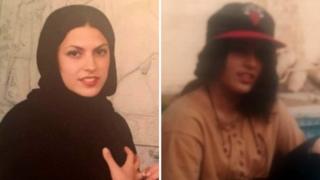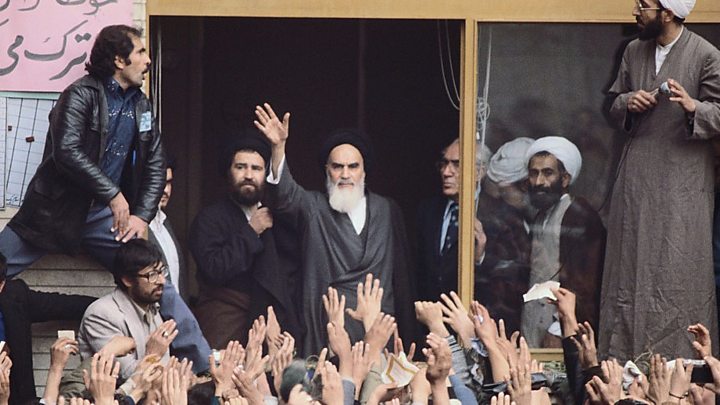Home » Middle East »
‘I wore a hijab and head-banged to Nirvana’
On my first day of school in Iran we walked down a poorly-lit corridor. I was holding my mother’s hand and crying. She was crying too. On my head I had a black hood, known as a maghnaeh, covering my hair. I was six years old and terrified. This was nothing like my kindergarten in Los Angeles.
I was born in the summer of 1979 in California, a few months after Iran’s Islamic Revolution; my mother was in her early 20s and my grandmother was 50.
Millions of Iranian women took part in the revolution, standing shoulder-to-shoulder with the men, but soon afterwards the tide turned against them. Some of the basic rights women had won during the regime of Shah Mohammad Reza Pahlavi were revoked immediately.
The Family Protection Act, which had given women the right to divorce, was nullified and a mandatory dress code requiring all women to wear the hijab was introduced.
The uprising against the shah and the revolution had scattered our family across the world.
I moved back to Iran with my parents in 1984, right in the middle of the eight-year war with neighbouring Iraq and one of the most ideologically rigid periods in the country’s recent history.
The dress code for women was strict; bright colours, lipstick, nail varnish or showing a strand of hair could get you arrested.
“I think the hardest thing for me was the hijab. I could never accept it,” my mother says. “I never followed the strict dress code dictated by the state. I tried hard to have my own style.”
My grandmother also struggled with the changes when she returned to Iran from the UK a few years after the revolution.
“I felt like I had moved to a completely different country, it was nothing like before,” she recalls.
‘Nothing like my school days’
Every morning before class we lined up in the schoolyard, raised our tiny fists in the air and repeated the words of our headmistress, who shouted into a megaphone: “Death to America! Death to Iraq and Saddam Hussein! Death to England!”
“The first day I took you to school I was shocked and disappointed,” my mother says.
It was quite different from her own time as a young girl in Iran. My mother attended a school founded by French Christian missionaries, where the girls wore cute uniforms, played sports and music, sang and danced.
“The environment of your school was depressing and sad,” she says. “It was nothing like the playful environment I remembered from my school days.”
My grandmother was part of the first generation of girls who attended public schools in Iran in the 1930s. Until then most attempts to open up girls schools had failed due to fierce opposition by the clergy, who believed they would become dens of indecency.
“I was fond of school. It was fun and I can’t remember anything unpleasant about it,” my grandmother says.
Under the shah religion was a private matter. After the revolution, religion became part of the public sphere.
You were encouraged to show your devotion to Islam as a sign of allegiance to the regime. Women had to dress more modestly, men grew beards and people prayed in work places out of fear of being branded anti-revolutionary. The state controlled the most private aspects of our lives.
Living a double life
At schools, teachers were told to quiz students about their private lives.
We were asked whether our parents drank alcohol, listened to music, owned a video player, played cards, danced or took off their hijabs at mixed-gender family parties; all acts prohibited by law.
Most of our parents encouraged us to lie and I started to learn how to live a double life.
I wore the hijab to class and head-banged to Nirvana in my bedroom at home. I shouted “Death to America!” at school and bought Guns N’ Roses cassettes from underground music dealers.
Growing up under the shah my mother had more social freedom.
“I could choose what I wanted to wear, the music I wanted to listen to and so forth, but there were still many limitations for women,” she recalls.
My mother married when she was 17, which was not uncommon even under the shah. Women were still expected to conform to rigid social norms and the gender gap in the workforce was wide. Yet the winds of change were blowing.
“The shah was trying to change things and make society more modern,” says my mother.
My grandmother grew up in an affluent family and was exposed to Western culture, but she was still very much bound to tradition.
She was married off after school and went on to have six children. She also didn’t have many choices in her life. Marriage and motherhood were just about all a woman could do.
Compared to my mother and grandmother I have had more choices in life; I got a university degree, emigrated alone when I was 30, lived with my partner for four years, and got married at 35. But this is not the life experience of an average Iranian woman.
Officials say more than 50% of university students are women and that they are postponing marriage until their late 20s. But women make up only 19% of the workforce. Most women still have little choice but to get married and become housewives.
Female representation in parliament is only 6% and women have next to no rights in marriage. Strict gender roles are propagated by state-run media and women are told that their place is at home with their children.
Four decades after the revolution, it is hard to say whether Iranian women have made any real progress. One thing is clear: for every step forward there have been a few steps back, but the setbacks have never discouraged women to push ahead.
Source: Read Full Article





